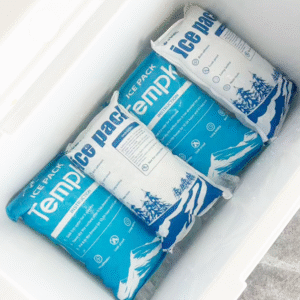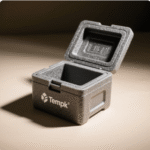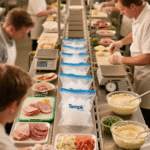How to Calculate the Sublimation Rate in a Bag: A Complete Guide
In the cold chain logistics industry, calculating the sublimation rate of dry ice in a bag is essential to ensure that temperature-sensitive products are preserved during transit. Understanding the rate at which dry ice sublimates allows businesses to optimize their packaging, select the right amount of dry ice, and manage transit conditions more efficiently.
This guide will provide you with practical formulas, key factors influencing sublimation, and emerging innovations in 2025 that can help you improve cold chain efficiency.
-
What is sublimation and why is it crucial for packaging?
-
How do you calculate the sublimation rate in a bag for effective packaging?
-
What factors impact sublimation rates in cold chain logistics?
-
What are the latest 2025 innovations in sublimation control and cold chain packaging?
What is Sublimation and Why Is It Important for Cold Chain Packaging?
Sublimation is the transition of a substance directly from a solid to a gas without passing through the liquid phase. In cold chain logistics, it specifically refers to the process in which dry ice (solid carbon dioxide) sublimates into carbon dioxide gas, which can pose safety risks if not properly managed.
Sublimation’s Impact on Product Integrity:
In cold chain operations, the sublimation of dry ice directly affects the cooling efficiency of packaging. If sublimation occurs too rapidly, products such as vaccines, perishable foods, or pharmaceuticals may be exposed to undesired temperatures, risking spoilage or damage.
By calculating the sublimation rate, logistics professionals can better manage how much dry ice to use, how long the cooling will last, and prevent the release of excess CO₂ into the environment.
How to Calculate Sublimation Rate in a Bag: Step-by-Step
Calculating the sublimation rate in a bag involves measuring the mass of dry ice that has sublimated over a given period of time. Here’s the basic formula:
Sublimation Rate Formula:
Sublimation Rate=Mass of Dry Ice SublimatedTime Taken for Sublimation\text{Sublimation Rate} = \frac{\text{Mass of Dry Ice Sublimated}}{\text{Time Taken for Sublimation}}
For a practical example:
If you start with 5 kg of dry ice and after 2 hours, 1 kg has sublimated, the calculation would be:
Sublimation Rate=1 kg2 hours=0.5 kg/hour\text{Sublimation Rate} = \frac{1 \text{ kg}}{2 \text{ hours}} = 0.5 \text{ kg/hour}
This simple calculation can help determine the rate at which sublimation occurs, allowing for optimized packaging strategies.
Factors That Affect Sublimation in Cold Chain Bags
Several environmental and material factors can influence the rate at which sublimation occurs in a bag. Understanding these variables can help you control and reduce sublimation to maintain the integrity of temperature-sensitive products.
-
Temperature: Higher ambient temperatures lead to faster sublimation. In hot environments, the sublimation rate increases, potentially causing rapid loss of cooling power.
-
Airflow: Increased airflow, whether from external sources or internal movement, accelerates sublimation. To slow the process, controlling airflow is key.
-
Humidity: Low humidity conditions can promote sublimation by reducing the moisture in the air, but excessive dryness may cause the ice to sublimate too quickly.
-
Packaging Material: The insulation quality of the packaging plays a crucial role. Bags with high-quality insulation slow down sublimation, while poorly insulated bags accelerate the process.
-
Size of Dry Ice: Larger blocks of dry ice sublimate more slowly than smaller pellets, as they have less surface area exposed to the air.
The Role of Packaging Materials in Sublimation Control
The choice of packaging materials significantly impacts sublimation rates. By using materials that offer better insulation, you can reduce the rate of sublimation and extend the cooling duration.
| Packaging Material | Insulation Quality | Effect on Sublimation Rate |
|---|---|---|
| Standard Plastic | Low | Fast Sublimation |
| Insulated Fabric | High | Slows Down Sublimation |
| Vacuum-Sealed Bags | Very High | Significantly Reduces Sublimation |
Recommendation: Use insulated bags, vacuum-sealed packaging, or materials with high insulation ratings to ensure the dry ice retains its cooling power for longer periods.
Practical Tip for Reducing Sublimation
-
Seal the Bag Properly: Ensuring the bag is tightly sealed minimizes airflow, which can slow down sublimation.
-
Use Larger Ice Packs: Larger dry ice packs sublimate more slowly and are better suited for long-duration shipping.
Latest Trends in Sublimation Control: What’s New in 2025?
The cold chain logistics industry is rapidly evolving with new technologies designed to improve sublimation control. As we move into 2025, several key innovations are reshaping how companies handle sublimation in packaging.
Emerging Technologies:
-
Thermally Regulated Packaging: Advanced temperature-regulated packaging systems are now able to maintain a stable cooling environment, reducing the need for constant monitoring and replenishment of dry ice.
-
Smart Packaging: Embedded IoT sensors that monitor temperature and humidity in real time are enabling companies to track sublimation rates more accurately and make data-driven decisions for replenishment.
-
Sustainable Cold Storage Solutions: Solar-powered cold storage and recyclable insulation materials are becoming more popular, offering an eco-friendly approach to cold chain logistics while still maintaining excellent insulation properties.
These innovations are not only improving the efficiency of cold chain systems but are also helping reduce environmental impact, aligning with sustainability goals in the industry.
Frequently Asked Questions (FAQ)
Q1: How can I minimize the risk of sublimation during long-distance transport?
Use insulated packaging and tightly sealed bags to minimize airflow. Also, monitor the temperature and humidity regularly during transport to maintain optimal conditions for sublimation control.
Q2: Does the sublimation rate vary depending on the type of dry ice?
Yes, smaller pellets of dry ice sublimate faster than larger blocks due to their higher surface area. For longer transport durations, consider using larger blocks to reduce the sublimation rate.
Q3: Can regular plastic bags reduce sublimation?
No, standard plastic bags are not ideal for minimizing sublimation. Use high-quality insulated or vacuum-sealed bags for better performance.
Conclusion and Actionable Recommendations
To effectively manage sublimation in cold chain logistics, it’s essential to calculate the sublimation rate accurately and optimize packaging choices. By selecting high-quality insulation, understanding the factors influencing sublimation, and integrating new technologies, you can extend the cooling duration and improve product safety during transport.
Action Steps:
-
Invest in insulated and vacuum-sealed packaging for better temperature control.
-
Regularly monitor temperature and sublimation rates during shipping.
-
Explore the latest cold chain innovations like IoT sensors and solar-powered systems for better performance and sustainability.
About Tempk
Tempk specializes in advanced cold chain packaging solutions, providing insulated bags and sublimation control products that ensure the safe transportation of temperature-sensitive goods. With over 10 years of expertise, Tempk offers innovative solutions that improve reliability, reduce costs, and enhance safety for cold chain operations.
Contact Us for expert advice on optimizing your cold chain processes and reducing sublimation risks.
























